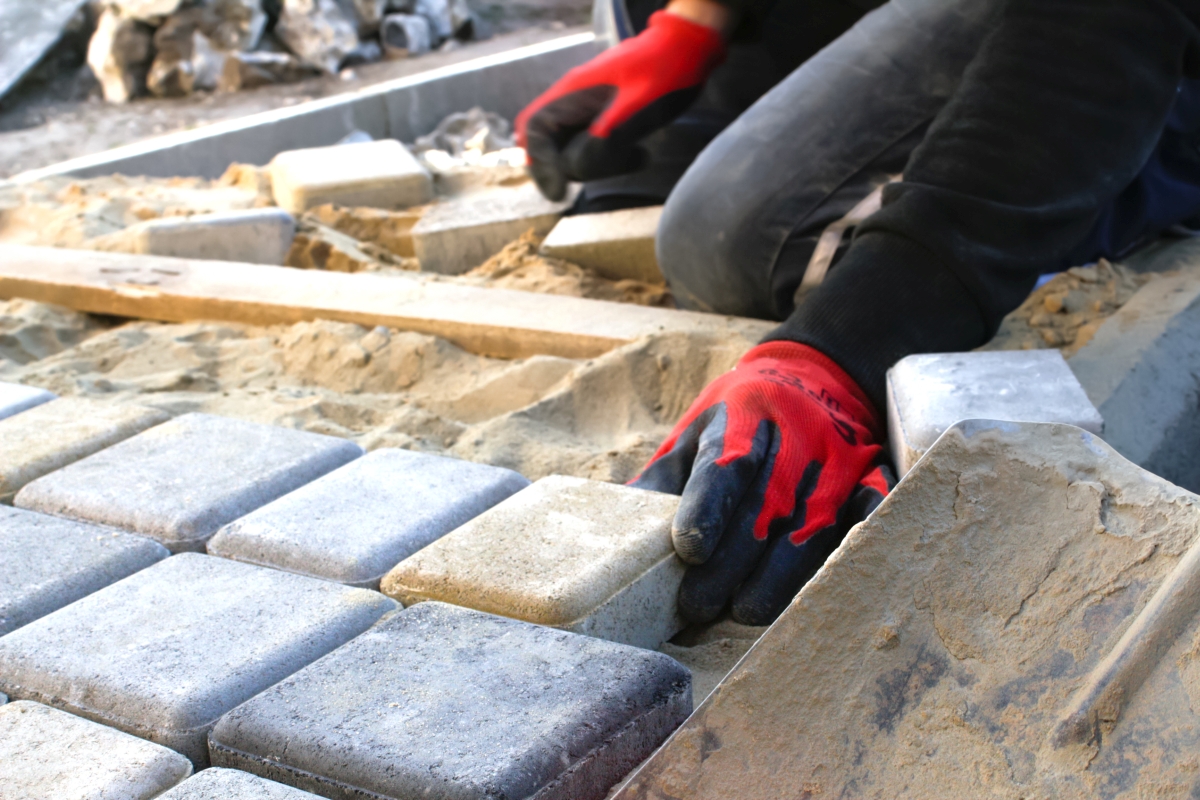Table of contents
- Specifics of the mobile paver and other machines
- When to choose the machine method?
- Where would the manual method be better?
- In what situations do you combine the two paving methods?
- Choose paving blocks to suit the laying method
- Most popular questions and answers
The manual method of laying paving is a common sight, while its alternative or complement is the use of machines that allow to significantly reduce the time of work, which is important especially on more extensive areas. Today, we will compare the above solutions and advise on which is best for your project, and when it is possible and worthwhile to use both.
Specifics of the mobile paver and other machines
In addition to a typical paver, a mini-excavator or mini-loader can be used, for example, as the key issue is the attachment, i.e. what will be fitted to the end of the arm. For such work, it is always a special grab that requires two separate hydraulic circuits. Its span is adjusted using a guide bar to suit the dimensions of the site in question and the dimensions of the layers on the pallet. This allows the operator to remove entire layers from the pallet, rather than individual pieces as in the manual method. The lifting capacity of the grapple is usually 400 kg or more, which in practice means laying about a square metre of paving each time a layer is removed from the pallet.
When to choose the machine method?
Modern paving machines are capable of paving up to 1,200 m2 per day, which is why they should be used wherever the largest areas need to be paved, such as town squares, boulevards, large car parks, estate roads, areas around warehouses and halls. Machine-laid paving has an inherently simple pattern. The thin design of the grab clamp ensures that the operator has a perfect view of the entire material and can operate efficiently throughout the work. Importantly, the paving pattern can be either simple or unusual, and for more finesse shapes, a positioning adapter or special adapter is used so that the gripper also holds each picked-up layer steadily for laying. However, this system will not work well for unusual projects, for example with motifs that require the cutting of many individual pieces.

Where would the manual method be better?
Of course, manual paving makes it possible to work wherever unusual shapes, compositions of elements with different shapes and colours have to be laid, as well as in areas where a level surface with a slight gradient cannot be achieved. In addition, manual paving is indispensable if the area in question cannot be overloaded (the total weight of the paver, including accessories and picked-up layer of paving blocks, is often more than one and a half tonnes) or if, due to the nature of the buildings, numerous permits would have to be obtained to allow the use of heavy or combustion machinery. This applies, among other things, to work in the vicinity of historic and historical buildings, natural protected areas, certain types of underground infrastructure. Fieldstone paving is also laid by hand.
In what situations do you combine the two paving methods?
Among the most typical situations in which it is worth considering supplementing the mechanical method with a manual one are the examples of compositions cited above, often encountered in the driveways of companies, institutions and commercial buildings. This concept also works well for streets and internal roads when slowdowns, also associated with paving, are included in the designs, but on suitably formed hills. These speed bumps are then paved by hand, while large areas without barriers can be laid by machine.
Choose paving blocks to suit the laying method
W ABW Superbruk We take care of a diverse range in order to meet our customers' expectations. By contracting an external paving company, you can obtain everything you need to carry out work on areas of any size from us. Paved surfaces are still in vogue and have been pleasing new users for years.
Most popular questions and answers
What are the advantages of laying paving stones by hand?
Hand paving allows the creation of intricate patterns, compositions from elements of different forms and colours, and works in areas where heavy equipment cannot be used.
When is it a good idea to use paving machines?
The machines are efficient on large areas such as town squares, boulevards or car parks, enabling simple paving patterns to be laid quickly.
What machines are used for paving?
The paving machines used include ride-on pavers, mini excavators and mini-loaders equipped with special hydraulic grabs.
Can manual and machine methods be combined?
Yes, in some projects, such as company driveways, both methods can be used, combining the speed of machines with the precision of hand laying for complex patterns.
How do you select paving stones for the laying method?
The choice of paving material depends on the laying method and the specifics of the project. It is advisable to consult the supplier to select the right material for the planned work.